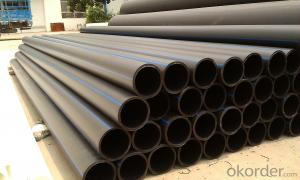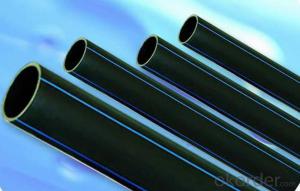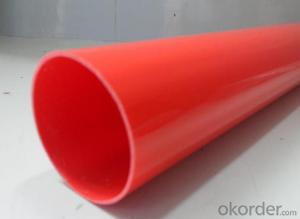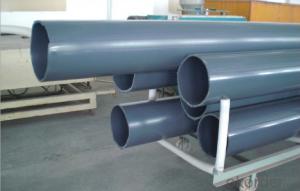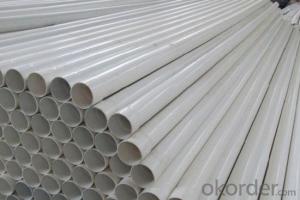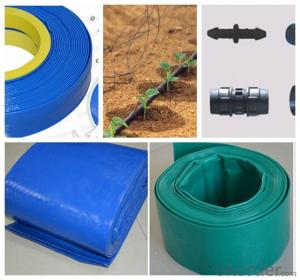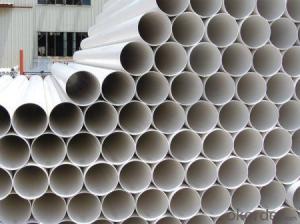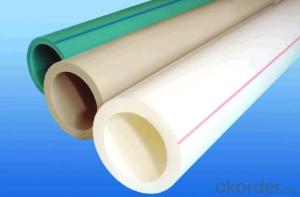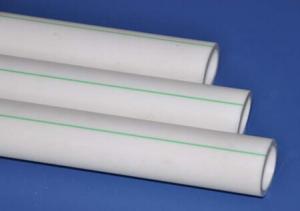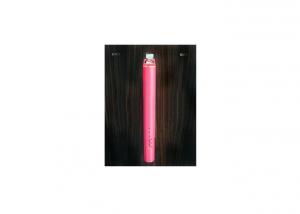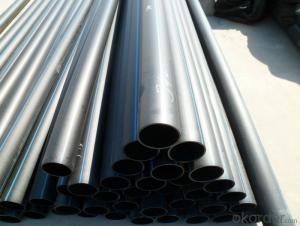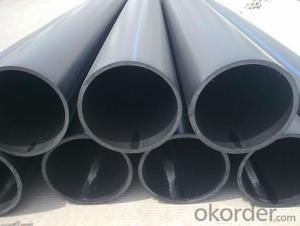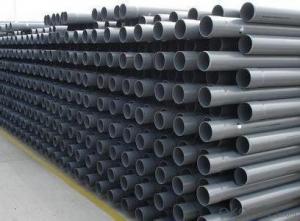Plastic Tubes HDPE Pipe ISO4427-2000 DN63
- Loading Port:
- China Main Port
- Payment Terms:
- TT OR LC
- Min Order Qty:
- -
- Supply Capability:
- -
OKorder Service Pledge
OKorder Financial Service
You Might Also Like
Physical properties[edit]
Polyethylene is a thermoplasticpolymer consisting of long hydrocarbon chains. Depending on the crystallinity and molecular weight, a melting point and glass transition may or may not be observable. The temperature at which these occur varies strongly with the type of polyethylene. For common commercial grades of medium- and high-density polyethylene the melting point is typically in the range 120 to 180 °C (248 to 356 °F). The melting point for average, commercial, low-density polyethylene is typically 105 to 115 °C (221 to 239 °F).it is transprant.
Chemical properties[edit]
Most LDPE, MDPE and HDPE grades have excellent chemical resistance, meaning that it is not attacked by strong acids or strong bases. It is also resistant to gentle oxidants and reducing agents. Polyethylene burns slowly with a blue flame having a yellow tip and gives off an odour of paraffin. The material continues burning on removal of the flame source and produces a drip.[3] Crystalline samples do not dissolve at room temperature. Polyethylene (other than cross-linked polyethylene) usually can be dissolved at elevated temperatures in aromatic hydrocarbons such as toluene or xylene, or in chlorinated solvents such as trichloroethane or trichlorobenzene.[4]
GB/T13663-2000:
| PE63管材规格 | |||||
| 公称 外径dn,mm | SDR33 | SDR26 | SDR17.6 | SDR13.6 | SDR11 |
| 公称压力 PN,Mpa | |||||
| 0.32 | 0.4 | 0.6 | 0.8 | 1.0 | |
| 公称 壁厚 | 公称 壁厚 | 公称 壁厚 | 公称 壁厚 | 公称 壁厚 | |
| 16 | 2.3 | ||||
| 20 | 2.3 | 2.3 | |||
| 25 | 2.3 | 2.3 | 2.3 | ||
| 32 | 2.3 | 2.4 | 2.9 | ||
| 40 | 2.3 | 2.3 | 3.0 | 3.7 | |
| 50 | 2.3 | 2.9 | 3.7 | 4.6 | |
| 63 | 2.3 | 2.5 | 3.6 | 4.7 | 5.8 |
| 75 | 2.3 | 2.9 | 4.3 | 5.6 | 6.8 |
| 90 | 2.8 | 3.5 | 5.1 | 6.7 | 8.2 |
| 110 | 3.4 | 4.2 | 6.3 | 8.1 | 10.0 |
| 125 | 3.9 | 4.8 | 7.1 | 9.2 | 11.4 |
| 140 | 4.3 | 5.4 | 8.0 | 10.3 | 12.7 |
| 160 | 4.9 | 6.2 | 9.1 | 11.8 | 14.6 |
| 180 | 5.5 | 6.9 | 10.2 | 13.3 | 16.4 |
| 200 | 6.2 | 7.7 | 11.4 | 14.7 | 18.2 |
| 225 | 6.9 | 8.6 | 12.8 | 16.6 | 20.5 |
| 250 | 7.7 | 9.6 | 14.2 | 18.4 | 22.7 |
| 280 | 8.6 | 10.7 | 15.9 | 20.6 | 25.4 |
| 315 | 9.7 | 12.1 | 17.9 | 23.2 | 28.6 |
| 355 | 10.9 | 13.6 | 20.1 | 26.1 | 32.2 |
| 400 | 12.3 | 15.3 | 22.7 | 29.4 | 36.3 |
| 450 | 13.8 | 17.2 | 25.5 | 33.1 | 40.9 |
| 500 | 15.3 | 19.1 | 28.3 | 36.8 | 45.4 |
| 560 | 17.2 | 21.4 | 31.7 | 41.2 | 50.8 |
| 630 | 19.3 | 24.1 | 35.7 | 46.3 | 57.2 |
- Q: Can plastic tubes be used for waste management systems?
- Yes, plastic tubes can be used for waste management systems. They are commonly used in various applications such as sewer lines, drainage systems, and underground piping for transporting and managing waste materials effectively. Plastic tubes offer advantages such as durability, resistance to corrosion, and ease of installation, making them suitable for waste management purposes.
- Q: My friend and I got these at the zoo once. We saw them at Candyworld and Schlitterbahn too. They are plastic, refillable tubes that you hold up to a dispenser. The candy is like what's inside a Pixie Stix. You pick the flavor/color. What are these called? We are trying to Google them. Thanks!
- i think they are called sandy candy from what i looked up.
- Q: Are plastic tubes suitable for DIY projects?
- Yes, plastic tubes are suitable for DIY projects. They are lightweight, versatile, and come in various sizes, making them ideal for a wide range of applications such as plumbing, gardening, and crafts. Additionally, plastic tubes are generally affordable and easy to work with, allowing DIY enthusiasts to create and customize projects according to their needs and preferences.
- Q: How do plastic tubes perform in low-pressure applications?
- Plastic tubes perform well in low-pressure applications as they are lightweight, flexible, and have good resistance to corrosion and chemicals. They are also cost-effective and easy to install, making them suitable for various low-pressure systems such as drainage, ventilation, and irrigation.
- Q: Can the rusty iron pipe be sawed off and connected to the plastic tube?
- The two scheme, if the specifications of the iron pipe, and not big, in 2 inches below, there are ready to buy quickly, buy a back and plastic pipe butt. If the iron pipe is too big or not in the specification, use pig iron to weld the mouth of the tooth you need.
- Q: Are plastic tubes suitable for structural applications?
- No, plastic tubes are generally not suitable for structural applications as they lack the strength and durability required to support heavy loads or withstand significant forces.
- Q: I remember we use to have tubes that bent up well but were very soft a tin like material that eventually they found because it had lead in them it leached into the toothpaste such that now we have plastic toothpaste tubes predominatly made in the US.
- That sounds about right. I do remember those tubes that rolled up easily and were made of a bendable metal. In those days, I was pretty bad about brushing my teeth so it's probable that I wasn't affected that much by whatever lead content there was. I did get a lot of cavities, though.
- Q: How can I clean my hookah pipe? I have a clear plastic medical tubing as the pipe (quick fix buy works great lol) and I can easily take it apart to clean BUT it's got tar stains inside the tube now, and I can't get the tar stains out of the plastic tube, I've tried bleach and some mild abrassive cleaners, even soap. Any tips?
- Let the tub fill up over the stains and allow it to soak for four hours. When the water drains out, you should be able to easily scrub off the stains. Clean the bathroom sink Non-gel toothpaste works as well as anything else to clean the bathroom sink. The tube's sitting right there, so just squirt some in, scrub with a sponge, and rinse it out. Bonus: The toothpaste will kill any odors emanating from the drain trap Good Luck !
- Q: Are plastic tubes suitable for cosmetic packaging?
- Yes, plastic tubes are suitable for cosmetic packaging. They are lightweight, flexible, and durable, making them ideal for storing and dispensing various cosmetic products such as creams, lotions, gels, and serums. Additionally, plastic tubes can be easily customized in terms of shape, size, and color, allowing for attractive branding and easy product identification.
- Q: im looking for a place to buy a small piece of latex tubing maybe about a foot long. i checked local pharmacy and drug stores with no luck. any other suggestions?
- Try Lowe's or Home Depot. I used vinyl tubing from Lowe's to fix my sink. I think they sell latex tubing as well.
Send your message to us
Plastic Tubes HDPE Pipe ISO4427-2000 DN63
- Loading Port:
- China Main Port
- Payment Terms:
- TT OR LC
- Min Order Qty:
- -
- Supply Capability:
- -
OKorder Service Pledge
OKorder Financial Service
Similar products
Hot products
Hot Searches
Related keywords
